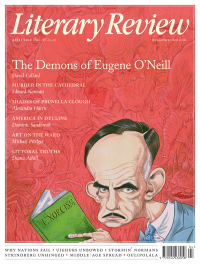Felipe Fernández-Armesto
Reality Entertainment
Peoples on Parade: Exhibitions, Empire, and Anthropology in Nineteenth-Century Britain
By Sadiah Qureshi
University of Chicago Press 382pp £29
The Comte de Gobineau was a notorious racist, but he got some things right. Mythical monsters, he suggested, emerge not from overactive imaginations but from impoverished thinking. Cultures label outsiders as demonic or bestial or imperfectly human because unimaginative people cannot conceive of strangers in the same terms as themselves. When European explorers and imperialists encountered unfamiliar cultures, therefore, they usually havered over where to place them in the classical and biblical panorama of creation. Henry the Navigator identified black Africans as woodhouses – the ‘wild men of the woods’ of medieval legend. Early woodcut images of cannibals in Java showed them as cynocephali – the dog-headed men reported in Pliny’s Natural History. Patagonia got its name from the reputed giants whom Antonio Pigafetta claimed to see when he sailed there with Magellan. Francisco de Orellana named the Amazon after the monstrous women that supposedly inhabited the river’s shores. Minds that expected marvels slotted new discoveries into the nether links of the Great Chain of Being, between humans and beasts.
Yet travelogues had a reputation for unreliable sensationalism, so doubts as to the very existence of monsters survived. More than 1,000 years before ocean-going voyages disclosed worlds of wonder in the Atlantic, St Augustine suggested that freaks of nature were illusory – evidence of men’s inability to see the beauty

Sign Up to our newsletter
Receive free articles, highlights from the archive, news, details of prizes, and much more.@Lit_Review
Follow Literary Review on Twitter
Twitter Feed
It wasn’t until 1825 that Pepys’s diary became available for the first time. How it was eventually decrypted and published is a story of subterfuge and duplicity.
Kate Loveman tells the tale.
Kate Loveman - Publishing Pepys
Kate Loveman: Publishing Pepys
literaryreview.co.uk
Arthur Christopher Benson was a pillar of the Edwardian establishment. He was supremely well connected. As his newly published diaries reveal, he was also riotously indiscreet.
Piers Brendon compares Benson’s journals to others from the 20th century.
Piers Brendon - Land of Dopes & Tories
Piers Brendon: Land of Dopes & Tories - The Benson Diaries: Selections from the Diary of Arthur Christopher Benson by Eamon Duffy & Ronald Hyam (edd)
literaryreview.co.uk
Of the siblings Gwen and Augustus John, it is Augustus who has commanded most attention from collectors and connoisseurs.
Was he really the finer artist, asks Tanya Harrod, or is it time Gwen emerged from her brother’s shadow?
Tanya Harrod - Cut from the Same Canvas
Tanya Harrod: Cut from the Same Canvas - Artists, Siblings, Visionaries: The Lives and Loves of Gwen and Augustus John by Judith Mackrell
literaryreview.co.uk